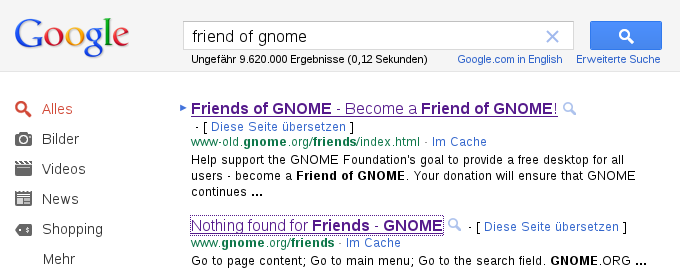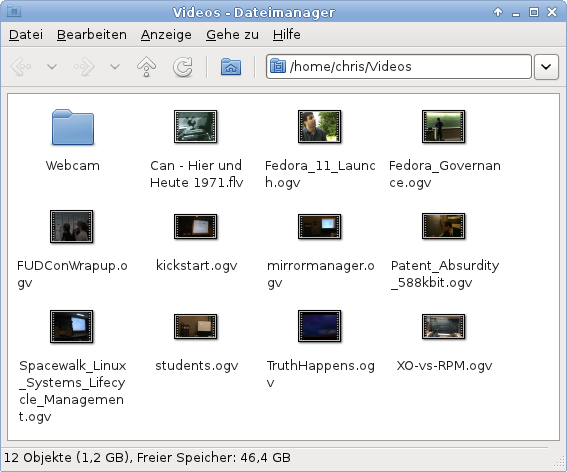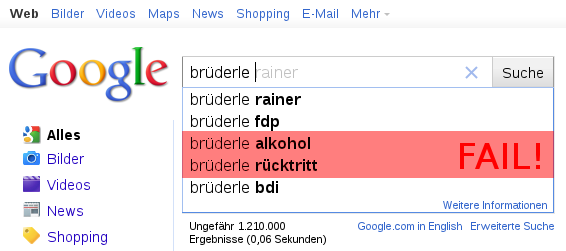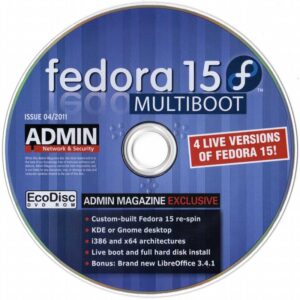Linux New Media to ship thousands of Fedora DVDs
As some of you might know I started writing for the German Linux Magazin in April. I am now in the lucky position to know quite a few people at Linux New Media and one of them asked me if I had an idea for the DVD they ship with their magazine. Of course I had: A Fedora Multiboot DVD.
First the editors were a little skeptic: Fedora is not that popular in Germany and many people still think it’s too bleeding edge, so Linux Magazin usually ships with save bets like Ubuntu or OpenSUSE. But when I told them about the new amazing features of our Multiboot media such as automatic detection of the CPU architecture and offered them to do a custom German spin, they agreed. So I made a prototype and it has taken a shine to them. 3 days later they asked for an English version, so it now ships not only with the German Linux Magazin but also with the English Admin Magazine. Look out for it in
- Germany: Linux Magazin is in stores as of today.
- UK and other European countries: Admin Magazine 04/2011 to be released on July 17th.
- North America: Admin Magazine to be released on August 12th.
- Australia and New Zealand: Admin Magazine to be released on September 12th.
I was told not to mention the exact number of media but trust me, it’s huge. It’s more media than the ambassadors produced for the last 3 or 4 Fedora releases worldwide.
And yes, I am fully aware that this media violates several guidelines and policies.
- It is a re-spin with updates included. We usually don’t to this but to conform to legal requirements, I uploaded the list of source packages to the correcponding-source git repo.
- It is a custom spin because the package selection is slightly different from the usual GNOME and KDE spins: It includes LibreOffice and for space reasons I had to leave all games out.
- The isolinux background is the Fedora 15 one but branded with the logo of Linux/Admin Magazine. However this only affects the DVD but not installed systems.
- I dared to call GNOME “GNOME” instead of “Desktop” in the boot menu. I guess I should just have called it “Desktop” and tell confused people to mail advisory board list to complain.
- I didn’t ask the Spins SIG but as the Spins Wrangler I ‘approved’ it myself. There really was no time for discussions, the images had to be ready and shipped to Munich in less than 36 hours.
- I didn’t ask the board either. I know how discussions on a board level tend to become and there really was no time.
Speak up if you think I have done harm to the Fedora Project!
New GNOME haz no friends

Me said it before and the internets have proved me right: New GNOME haz no friends, only old GNOME haz.
P.S.: Bad troll post, I know but SCNR! 😉
Video thumbnails in Thunar
As you might know thumbnails in Thunar are generated with tumbler. For obvious reasons the tumbler package in Fedora cannot include the tumbler-ffmpeg plugin. By popular demand I now rolled an add-on package called tumbler-freeworld. When installed, this is what it looks like:

If you are a packager at RPM Fusion, please review the package. Fedora’s Xfce users will appreciate your help.
GNOME developer quote of the day
I am no longer using GNOME but Xfce and this has nothing to do with GNOME Shell. I already switched a long time ago. But as the (co-)maintainer of several terminals in Fedora, I wondered how to enable users to easily switch their default terminal emulator in GNOME 3.
In the past users could just select the their favorite terminal in gnome-default-applications-properties. Some things required additional configuration: For a mail client the system needs to know the command to compose a new mail or to add attachments and for a terminal emulator an option to run something in a terminal is required. Developers could pre-configure these values with an xml file in $(prefix)/gnome-control-center/default-apps.
When I asked how to do all this in GNOME 3, Bastien (who helped to invent this nice mechanism in GNOME 2) after a little back and forth told me how things work in GNOME 3. They don’t…
“Because we’re not designing a desktop for people who like to choose their own terminal emulators.“
This “We are not designing a desktop for people who …” has become a new meme. GNOME 3 is not designed for people
- who want to minimize windows
- who want to change the theme, icons or fonts
- who want to configure power management actions
- who want to use panel applets/extensions that can easily be added or removed
- who want to select their native language on the login screen instead of having to re-login after they have changed it in the control center
- who want to use their keyboard layout so they can actually log in
- who want to shutdown their computers from within a GNOME session
and many other people I forgot. If GNOME continues to narrow down their target audience like this, I wonder if there is actually somebody left.
Simple tasks like selecting a preferred application are made very hard just to then claim “This is something only hackers do”. In the past one could just remove the accessibility or bluetooth icons from the panel by not starting them, now one needs to write extensions for that purpose. One even needs an extension to move the clock. But wait: Is GNOME 3 designed for people who know how to write extensions?
If you think that GNOME is still a nice desktop after all and should not become too simplistic, please support my RFE by adding your two cents. Too bad voting in GNOME’s bugzilla is disabled.
Announcing the Kolab Server 2.3.2
I’m sorry it took so long, but good things take a while. I am relieved the release is out because now that the problems with FreeBusy are solved, the 2.3 series offer the same functionality as 2.2.4 – plus much more of course.
New features
The update to postfix 2.8 brings a lot of new features like postscreen and multi-instance support. However none of them is enabled by default and old configuration files continue to work. Have fun while exploring the new possibilities, we will make use of them in the next major release.
Bugfixes
Most of the bugfixes affect Kolab_* packages such as Kolab_FreeBusy:
- apache-php: Security update fixing various CVEs
- Kolab_FreeBusy: Generating free/busy cache works again
- Kolab_Resource: Answers from resources no longer contain extra “\r\n\r\n”
characters - Kolab_Server: IMAP connection issues fixed
- Kolab_Storage: Webclient no longer hangs if freebusy triggering/retrieving
hangs - kolab-webadmin: Listing of sub-folders and sub-calendars was fixed
- kolabd: Fixed an imap annotatoin so SyncML can sync contacts
- php: Security update fixing various CVEs
- postfix: Security update to 2.8.3. This also brings a lot of new features
- z-push: New version with many bug fixes, rebuilding with prefixes other than /kolab fixed.
For a complete list of changes please refer to the release notes.
Upgrading
The upgrade form 2.3.1 is straight forward, there is nothing special you need to care about. If you are upgrading from 2.2.4, please follow the instructions to upgrade from 2.2.4 to 2.3.0 as outlined in the 1st.README file.
Downloads
Documentation and OpenPKG packages are available as shown on the download page. Binary packages for Debian GNU/Linux 6.0 (Squeeze/stable) and 5.0 (Lenny/oldstable) on x86 platforms can be found next to the sources. As soon as they have synced, you can also use the mirrors.
You can check the integrity of the downloaded files by importing our file
distribution key and verify the OpenPGP signature and SHA1 checksums:
$ wget https://ssl.intevation.de/Intevation-Distribution-Key.asc $ gpg --import Intevation-Distribution-Key.asc $ gpg --verify SHA1SUMS.sig $ sha1sum -c SHA1SUMS
Known bugs
- Bug 98 – Not all folders in the new ActiveSync config are displayed. We are working on that.
Please report bugs in our bug tracker.
Announcing the Kolab Server 2.3.1
Yesterday late at night I finished the the Kolab Server 2.3.1.
Features
There are not many new features because it is a bugfix release, but in the
webadmin you new will find a new ActiveSync configuration. It will work for
most users, however not completely for power-users with lots of nested and
shared folders, so please consider it only a technical preview.
Bugfixes
Most of the bugfixes affect the webadmin, cyrus-imapd and z-push:
- cyrus-imapd: Work around for missing user_deny.db
- cyrus-imapd: Properly flush buffer after TLS initiation
- kolab-webadmin: Problems with new UID based dn were fixed
- kolab-webadmin: LDAP Error for maintainers group was fixed
- kolab-webadmin: New welcome pages now work for all users
- kolab-webadmin: Multi-language function was fixed
- kolab-webadmin: Kolab Server version string was fixed
- z-push: The alias “Microsoft-Server-ActiveSync” now works out of the box
- z-push, kolab-z-push and PEAD-Kolab_Zpush: New versions with many bug fixes
For a complete list of changes please refer to the release notes.
Upgrading
The upgrade form 2.3.0 is straight forward, there is nothing special you need to care about. If you are upgrading from 2.2.4, please follow the instructions to upgrade from 2.2.4 to 2.3.0 as outlined in the 1st.README file.
Downloads
Documentation and OpenPKG packages are available as shown on the download page. Binary packages for Debian GNU/Linux 6.0 (Squeeze/stable) and 5.0 (Lenny/oldstable) on x86 platforms can be found next to the sources. As soon as they have synced, you can also use the mirrors.
You can check the integrity of the downloaded files by importing our file distribution key and verify the OpenPGP signature and SHA1 checksums:
$ wget https://ssl.intevation.de/Intevation-Distribution-Key.asc $ gpg --import Intevation-Distribution-Key.asc $ gpg --verify SHA1SUMS.sig $ sha1sum -c SHA1SUMS
Known bugs
There are still two bugs in freebusy and the resource management:
- Issue 4730: Generating free/busy cache broken in server 2.3.0
- Issue 4731: Answer from resources contains extra “\r\n\r\n” characters
These will be fixed in 2.3.2 and we will offer packages for testing next week. Please report bugs in our bug tracker.
Development roadmap
As 2.3.1 was released two weeks after 2.3.0 and I’d like to stick with the two-weeks cycle. This means that the Kolab Server 2.3.2 will be released on Friday, May 13th. Yes, this is an unlucky date, not because I’m superstitious but I will be busy. This might even mean I will release earlier.
Announcing the Kolab Server 2.3.0
For the plane in the fog, the mountain is unforeseeable, but then it is suddenly very real, and inevitable.
Simon Forster, Minister for foreign relations [1]
And so is the release of the Kolab Server 2.3.0. It was a bumpy ride and I’d apologize for the delays, but now we made it!
Features
The new Kolab 2.3.0 server includes a lot of new features, namely:
- Z-push synchronization for mobile devices
- a reworked webadmin
- the possibility to have multiple accounts with the same name.
- modular packaging of the webclient
- many updated core components
- tons of bug fixes
A detailed list of changes is available in the release notes.
Upgrading
Because of the changes in LDAP, upgrading from 2.2.4 is not trivial and requires manual intervention. Please make sure you read and follow the upgrade instructions.
Downloads
Documentation and OpenPKG packages are available as shown on the download page. Binary packages for Debian GNU/Linux 6.0 (Squeeze/stable) and 5.0 (Lenny/oldstable) on x86 platforms can be found next to the sources. Support for Debian GNU/Linux 4.0 (etch/oldstable) was dropped because it is no longer supported by Debian ether. As soon as they have synced, you can also use the the mirrors.
You can check the integrity of the downloaded files by importing our file distribution key and verify the OpenPGP signature and SHA1 checksums:
$ wget https://ssl.intevation.de/Intevation-Distribution-Key.asc $ gpg --import Intevation-Distribution-Key.asc $ gpg --verify SHA1SUMS.sig $ sha1sum -c SHA1SUMS
Notice
This release marks the end of a long development cycle. After over 2 years, the master and the stable branch are (more or less) in sync again. We introduced many new features and fixed a large number of bugs. We tested the release intensively but due to the massive code changes, we might have missed something or even introduced new bugs.
Before you use this release in a critical environment, we’d like you to test it. Please report any problems you encounter in our bug tracker.
Depending on the number and severity of bugs, we will issue an updated release soon. We already have a number of fixes in the queue such as the today’s Z-push 1.5.2 release, so Kolab 2.3.1 will come soon.
Credits
I’d like to thank a few people for their help, namely and in no particular
order:
- Paul and Georg, for giving me the chance to work on a great project like Kolab
- Bernhard for his coordination
- Thomas and Sascha for their support, especially during this week
- Bogo for the awesome new look of the webadmin
- Jeroen for his input and providing me the infrastructure I need
- Gunnar for responding so fast to the issues we spotted
Without these people the Kolab Server 2.3 would not be possible. Thanks everybody for your hard work!
[1] In the excellent movie “In the loop“
I want you to vote…
 … for the Beefy Miracle! NOW!
… for the Beefy Miracle! NOW!
Chemnitzer Linux-Tage 2011 revisited
Last weekend I attended the Chemnitzer Linux-Tage 2011, one of the biggest community events here in Germany. The reason I didn’t blog about it earlier is simple: I didn’t know what to write except: It was like every year.

This doesn’t mean that the event was bad, by far not. It was just as great as every year. You really can rely on the CLT people, they have a fantastic group of volunteers to help out at the event. They take care of everything, no matter what it is. The catering was extraordinary once again, especially on the social event on Saturday evening.
I would have liked to party harder, but I had to give my Kolab talk on Sunday morning, so I went back to the hotel early. Why do I always get the slots on the morning after the social event? Happened to me at FOSDEM 2009 and OpenRheinRuhr 2010 already. 🙁
As every year I met quite a lot of people at Chemnitz, way too many to name them all. The Fedora team consisted of Jörg, Robert, Fabian, Sven, Jens and me (obviously). With Michael and Dominic two more Fedora contributors were helping at the Xfce booth but unfortunately our Czech friends from Red Hat Brno could not join us.

I managed to get rid of a lot of media. I had 7 boxes with me, roughly 700 discs. One box was picked up by Vinzenz for Augsburger Linux Info day next week and two are for Gerold for the Linux Days Graz in April. Fabian was so kind as to take them with him and drop them off at Gerold’s on his way home to Switzerland. The other 4 boxes were mostly distributed at CLT and the rest was given to somebody for another event. I like really this distribution method: Fast, effective and inexpensive.
On the negative side we have the “Battle of the distributions” on Saturday. It was not really a battle because the different distros (Debian, Fedora, Mandriva, OpenSUSE, Pardus and Ubuntu were not fighting but rather showing how to manage a particular task with their latest release. The first exercise was how to view YouTube. As we all know YouTube doesn’t run with gnash, so this means installing the proprietary Adobe Flash plugin. 🙁
I have to admit that it’s a typical problem beginners are facing, so it is a valid exercise, but it’s not really a good example to compare the quality of the distributions. If the first thing on a free software event is to install unfree software, something is wrong.
The winner was Ubuntu here, they have patched the Firefox plugin finder to not only find the Flash plugin but also to install it through apt. On the other hand Ubuntu had some problems later when somebody asked how to revoke the sudo privileges of the first user (only possible on the console). Fedora also didn’t do that bad: I had to go to the Adobe homepage, but at least they offer a yum repository, so we could do a completely graphic click-through install and will get updates later.

Unfortunately this was not only the first but also the only exercise because things got a little chaotic afterwards. The Pardus guy managed to completely screw up his machine before the competition started, so he had to reinstall it while we were already doing the Flash exercise. We skipped him and when we all were finished, it was his turn. He still hadn’t finished his install, but he had all the time in the world to show their first-run wizard and configure icons, wallpapers and some more stuff, before the wizard crashed. So he went through it again and when he was done, there was nothing left to do because Pardus delivers all kinds of questionable proprietary software out of the box. They even package Windows Binaries for wine!
To me Pardus was clearly the looser, their X crashed every time when it was switched to the big screen, but the Pardus guy managed to turn failure into a win: The more problems he had, the more time he had for telling how great Pardus is. The presenter was to kind to interrupt him, so it became a Pardus show. Fedora at least got some extra attention when I was to tell something in SELinux and I was told that my presentations were pretty convincing, but other great distributions like Debian only had 5 minutes to show their work.
Apart from this Chemnitz was really great again – but you don’t expect something different.
(Thanks to Jörg for his blog posts and his photos and to Fabian for his event report)


